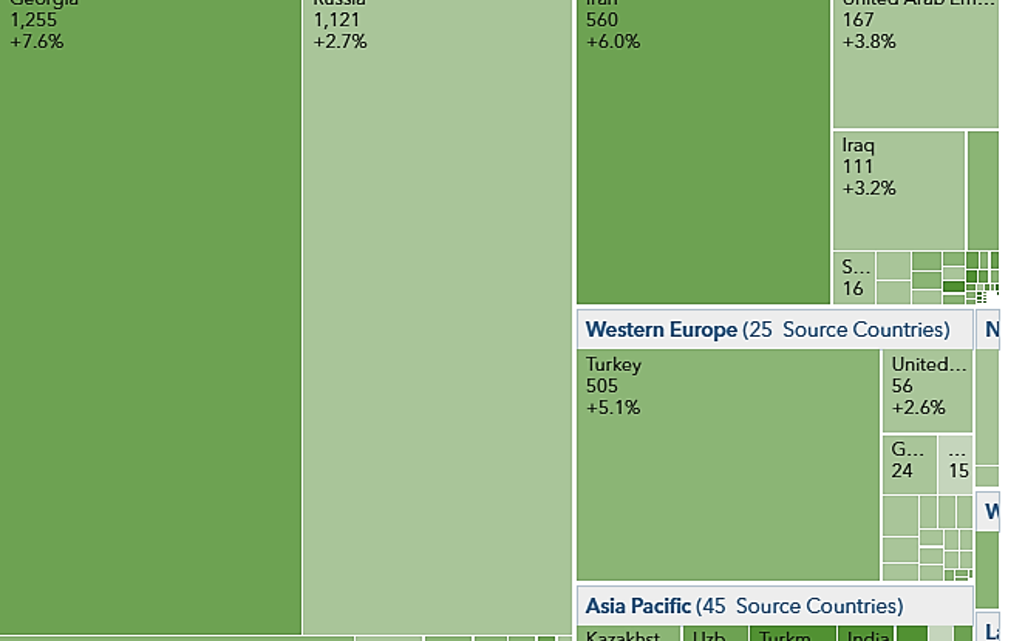A version of this article appeared on Skift.com in December 2018.
Central Asia is a region that has been going through a transformation process to improve the business environment and increase its attractiveness for foreign investment. Participation in different Belt and Road Initiative (BRI) projects worth billions of dollars, whether in terms of infrastructure development, trade or logistics, will lead to diversification of these economies away from oil and gas. The region can reap the benefits of its geographic position between East and West.
With a focus on infrastructure developments as part of the overall BRI project in Central Asia, the tourism appeal is expected to improve in the region and in turn boost tourism flows and diversify away from traditional source markets.
Contrasting performances
Most of the economies in Central Asia are reliant on their natural resources, which have been the driving factor in their growth since independence. Because of their geographic location, many of the countries are aiming to benefit from China-Europe trade traffic.
Local governments in the region are looking to develop modern tourism infrastructure, which can help attract more visitors from Asia Pacific and Europe. The natural resources and cultural heritage provide the opportunity for continued growth in the leisure segment.
Other opportunities exist to attract more business visitors and thus capitalise on some of the major business events in the region (e.g. Expo 2017 in Kazakhstan). Additionally, the luxury and upscale hotels segment is enjoying strong exposure in this part of the world through brands such as Ritz-Carlton, St Regis, Fairmont, Four Seasons, Hilton and Hyatt.
Destinations such as Azerbaijan and Kazakhstan stand out in terms of economic performance thanks to stronger political and commercial ties with China.
Finding the right market niche for differentiation
Azerbaijan’s focus on hosting major sporting and cultural events such as the European Games, Formula 1 Grand Prix and Islamic Solidarity Games positively influences the development of tourism infrastructure in the country and attract investment.
Such events can help the country promote its destination and prepare the market to cater to a higher number of tourists. Targeting new source markets and introducing attractive promotions can further boost the appeal of the country for such events, in addition to the government’s efforts to promote medical, meetings, incentives, conferences and exhibitions (MICE) tourism and sun and sea tourism. Inbound arrivals in the country are projected to reach 4.5 million trips by 2030, according to Euromonitor International.


Source: Euromonitor International Travel Forecast Model
Overcoming obstacles for future growth
More needs to be done in Central Asia in terms of the regulatory and business environments to support the increased capacity and demand that can be derived from projects such as the BRI.
Infrastructure developments will be vital to stimulate growth and bridge the gap that exists with developed markets, especially in tourism and transportation. The lack of open skies agreements, however, deters mobility of people.
Liberalisation of air transportation will eliminate entry barriers and lead to a more competitive environment. Allowing the entry of more low-cost players will in turn increase investment in the economy, as well as revenues from tourism and business activities.
Improved connectivity between the East and West can facilitate the transfer of knowledge and technology, which can help boost underdeveloped parts of the region. At the same time, regional cooperation can reduce cross-border trade costs and bring more integration to this part of the world.
It is important to recognise that overreliance on one market—in this case China—could expose these countries to economic influence. BRI uncertainties are very much related to the fact that the project is a work in progress, with many unknowns and political risks, along with some concerns about its impact on the environment.
